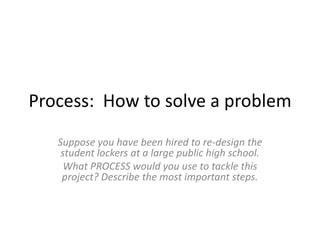
Process assignment 1
- 1. Process: How to solve a problem Suppose you have been hired to re-design the student lockers at a large public high school. What PROCESS would you use to tackle this project? Describe the most important steps.
- 2. • First, I would understand why a redesign is in order. What's the goal? • Second, list all of the needs that are currently met - storage, communal gathering, corridor barriers. • Third, are there others that could be met? Furniture, environmental support, integrated with a recycled water project ... • Finally, are there requirements otherwise: They must be blue, or metal, or have specific securing requirements. This means interview stakeholders. • Then brainstorm on whiteboards how to meet each need - separately if possible - and then try to pull together multiple ideas into a new, unique solution.
- 3. Understand the original reason behind the problem. Identifystakeholders – ALL stakeholders. – students, teachers, administrators, parents, janitorial and maintenancestaff. Are there others? Interviewstakeholders and prepare to list and rank requirements What issues was the current solution solving? (solutions don’t come about in a vacuum. Even bad ones met some need.) Are there other issues that the future solution could address that are not in scope but could make it better or more innovative? Are there limitingrequirements? Materials, budget, color, texture, security, access, etc Without boundaries, start to solve individual problems – address individual requirements. NO JUDGEMENT Assimilate solutions and compare to all requirements Ask for review by stakeholders Settle on a solution. Make a budget. Make a schedule and plan.